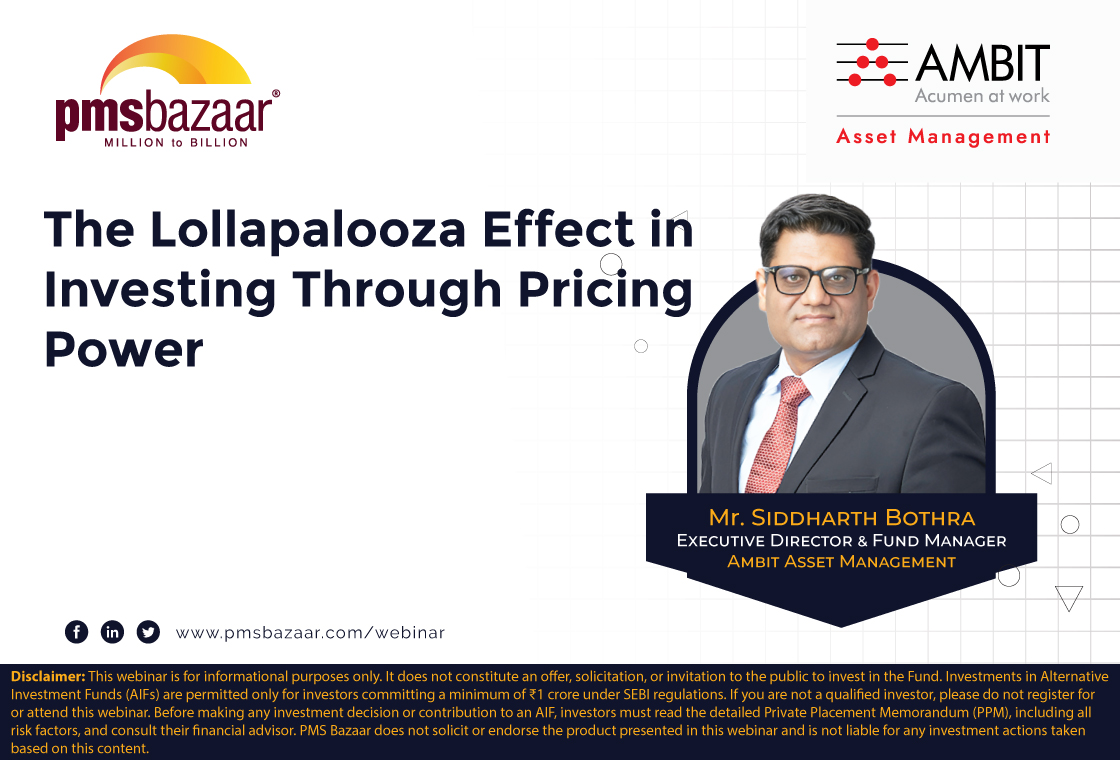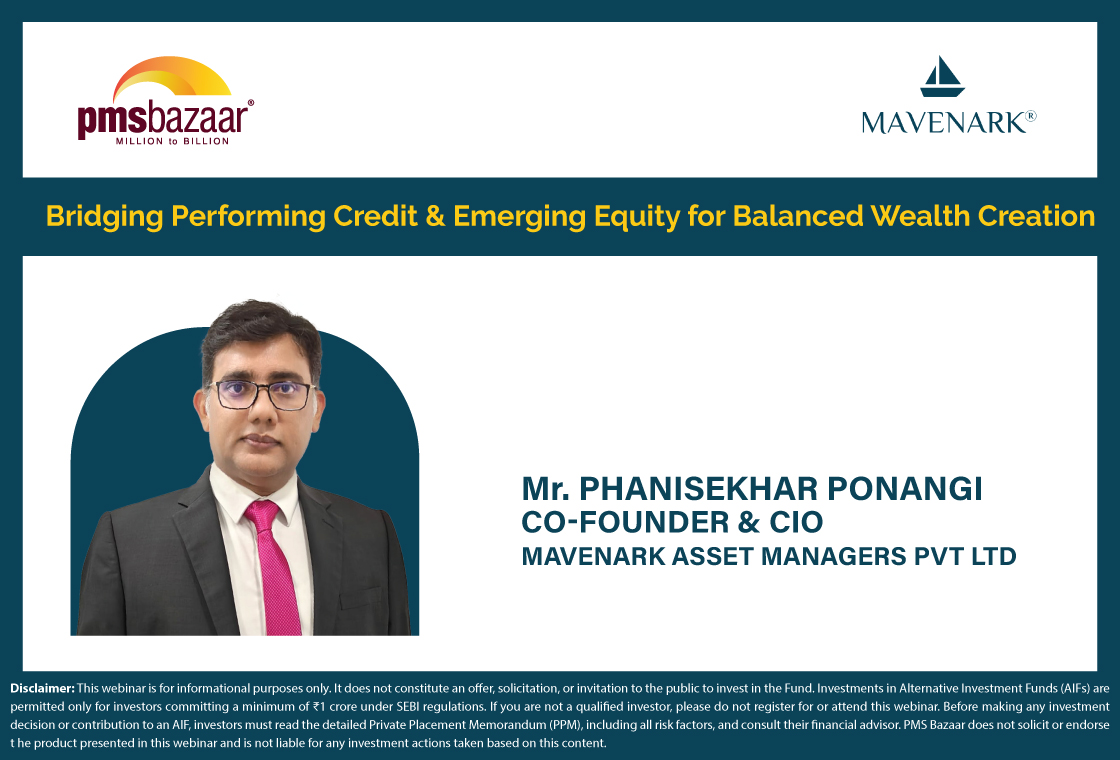PMS Bazaar recently conducted a Podcast Interview Series - "The Power of Compounding Wealth," where seasoned Fund Managers reveal their invaluable insights into financial success and wealth-building strategies. This blog covers the excerpts from the second episode of this interview series, with Mr. Prateek Agrawal, Executive Director, Motilal Oswal Asset Management, as the guest speaker.

Excerpts from the Podcast
Compounding is vital as the gateway to accessing remarkable possibilities for constructing and augmenting wealth. As investments persistently compound over prolonged durations, the influence grows considerably noteworthy, establishing the bedrock for noteworthy financial achievements. In this particular scenario, Mr. Prateek Agrawl offered enlightening perspectives while addressing numerous crucial inquiries during the interview.
Navigating Market Highs: Sustainability and Investment Strategy
Mr. Prateek was asked about the current state of the markets, which are at an all-time high. While the Sensex has reached approximately 66,000 points, the Nifty is at around 19,700 levels presently. The underlying question is: what is driving the fundamentals of the market?
According to Mr. Prateek, the current market levels appear sustainable. While the indices have reached near their all-time highs, the valuations haven't skyrocketed. Over the past year, He stated that we have witnessed a gradual compounding of earnings since the previous peak, lending support to the index. Therefore, valuations aren't overly inflated.
Moreover, a sustainable range for the Price-to-Earnings (P/E) ratio for the next year is around 18 to 18.5 times. Assuming estimated Nifty earnings of 1100 with a P/E range of 18.5, this could lead to a level of approximately 20,300, reflecting a 45% increase by year-end. Even considering the lower estimates, the market would still be within sustainable levels.
It's essential to acknowledge that entering the equity market for a potential 4-5% upside over a few months might not seem enticing. However, it's important to remember that markets exhibit a pattern of earnings compounding. If the market maintains its levels for a quarter, it might experience fluctuations of around 3-4% in valuations. This is part of a normal correction in expectations versus reality.
Exploring International Markets and Assessing Market Optimism
Mr. Prateek was asked about his adept approach to delving into the intricacies of international markets. Many global markets have showcased remarkable achievements in the present year, surpassing the observed trends. Importantly, India's market has also grown, prompting a pertinent line of inquiry. Expanding upon this, Mr. Prateek was prompted to share his perspective on whether he foresees the enduring global market surge and explore the foundational factors fostering optimism within the market.
For this, Mr. Prateek stated that it's worth acknowledging that while global developments can certainly inspire investor confidence, the once-ubiquitous correlation between Indian markets and those of the West (such as the US and Europe) or the East (like China and Japan) has gradually diminished over time. Reflecting on the period before the Lehman crisis, markets had remarkable synchronicity. Yet, as the years have passed, markets have begun to chart their courses based on distinct fundamentals. In the past, there were instances where India thrived while the global scenario was less favorable, and vice versa; China's emergence onto the global scene also ushered in a shift in dynamics.
This transformation can be attributed, in part, to the changing dynamics of foreign portfolio investments (FPIs). Previously, the same pool of global funds propelled markets worldwide, leading to a high correlation. However, since the Lehman crisis, China has transitioned from being a significant FPI recipient to a major provider of FPIs globally. Consequently, its market performance is now driven more by its internal policies and economic landscape than FPI activity. A similar trajectory can be observed in India, although we may be a decade behind. From 2007-2008 to 2023, a span of 15 years, we've witnessed a discernible shift.
In the current scenario, Indian investors are entering the market in a structured manner. This observation reveals a pattern where they increase their investments during market downturns and moderate them during periods of exuberance, all while maintaining a consistent commitment to investing. Additionally, the prevalence of Systematic Investment Plans (SIPs) in mutual funds has bolstered the structural nature of the investment. As a result of these trends, domestic flows have gained prominence, effectively tempering the influence of global flows. Consequently, when FPIs engage in selling, the market might experience a modest decline of around 3-4% in a month. A reduction in selling intensity might lead to a market fluctuation of around -1% to +1%, whereas coordinated buying from domestic and FPI investors could potentially result in a 6-7% gain over a fortnight. This nuanced dynamic characterizes the present market landscape.
Further, Mr. Prateek highlighted that we needn't rely solely on global cues to gauge the trajectory of Indian markets. Indian markets exhibit a certain degree of independence due to the neutral stance of policies. Unlike aligning with specific camps, national policies are characterized by a remarkable degree of autonomy. The substantial forex reserves and monetary policy's autonomy distinguish India from other nations. While the US and Europe have embarked on a trajectory of interest rate hikes, India has thus far refrained from such actions. The escalating forex reserves empower the Reserve Bank of India (RBI) with the latitude to abstain from rate hikes. Currently, it appears that the RBI cannot raise rates while other economies are doing so. This confluence of factors contributes to a diminished level of correlation.
This reduced correlation is, in fact, a positive development. Diversification is a driving force behind global investors seeking out different markets, and the Indian market now presents an appealing option in this regard. It's heartening that the Indian market has grown in depth and offers substantial diversification advantages. For instance, despite significant FPI selling, the market demonstrated resilience in the past year, holding up well compared to others. As the market intensifies and diversifies, it becomes an increasingly attractive proposition for global investors. In summary, the Indian market's unique attributes and evolving dynamics contribute to its distinct trajectory, reinforcing that it can independently harbor optimism even as global markets fluctuate.
Considering alternative investment options, such as debt, a popular choice in India, the tax implications play a significant role. With higher-yielding debt options taxed at 43% for high-net-worth individuals earning over 5-10 crores, the equity hurdle rate becomes around 5%. Given this scenario, equity could reasonably offer a pre-tax return of about 6%, making it competitive against other asset classes.
The prevailing sentiment among investors seems to oscillate between confusion and hesitation. Long-term investors contemplate whether to secure profits and exit, while newcomers grapple with the decision to enter now or await a potential market dip. If I were in their shoes, I would consult asset allocators. Diversifying investments across various asset classes, including equities, real estate, and gold, can provide a strategy to manage uncertainties.
For those who haven't initiated their investment journey, it's worth noting that equity, considering its post-tax attractiveness and compounding potential, can be an appealing choice. In a rapidly growing economy like India, holding onto equity for an extended period can mitigate the impact of entry-point valuations. Over a span of 12 to 15 years, the difference in compounding between market entry at high and low points might be a mere 2 to 3%. Initiating and maintaining an investment plan over the long term can help smooth out these variations.
Risk Management in Investment Funds and India's Economic Growth
Next, Mr. Prateek was asked about the risk management of funds, especially considering the long-term nature of investment components.
According to Mr. Prateek, risk management is a crucial pillar in their strategy. Businesses can substantially curb potential risks by prioritizing quality and competent management. This is a buffer against suboptimal asset allocation decisions and unsuccessful equity fundraising for future growth. Further, Mr. Prateek highlighted that the initial step involves singling out businesses possessing a baseline quality that ensures sustained growth over multiple years. Balanced Portfolio SA strategy centered on balanced portfolios with uniform weightage is employed. Most portfolios assign 5-6% to the foremost holding, underscoring the commitment to investments built on strong conviction.
Premium portfolios, composed of less than 30 stocks, underline the conviction-focused approach. This equates to 5-6% for dominant holdings and 2-2.5% for bottom-tier holdings, preserving a level structure. A robust mechanism of rebalancing and stop-loss protocols provides the foundation for systematic risk control. The bedrock of Motilal Oswal’s risk control lies in selecting market sectors where the amalgamation of quality, growth, and valuations harmonizes, focusing beyond mere ROCE maximization. Despite proactive measures, persistent external risks necessitate attention, such as market undulations, geopolitical occurrences, or economic fluctuations. The portfolio encompasses stocks capable of flourishing in favorable circumstances while counterbalanced by those resilient during adversity. This ensures preparedness against unforeseen risks.
In the current equity landscape, with advanced trading practices, market expectations are often already factored in. For instance, events like economic slowdowns are anticipated and priced into the markets well ahead of their occurrence. The advent of large positions in the option and futures market accelerates the impact of such events, resulting in an impact before the actual event unfolds.
India’s Economic Growth
Mr. Prateek was asked to share his perspective on India's growth trajectory, particularly in its journey toward becoming a $5 trillion economy and beyond. In this context, Mr. Prateek’s viewpoint is centered around unlocking the potential of India's sizable population. Despite India's ranking as the world's third-largest economy, Mr. Prateek stated that India’s per capita income remains modest due to its substantial population. India must focus on generating more employment opportunities to catalyze economic growth, particularly within the manufacturing sector.
While the services industry has experienced remarkable growth, India must recognize that manufacturing holds untapped potential to contribute significantly to employment generation. Mr. Prateek emphasized the need to seize the current global dynamic shift, with many countries seeking alternative manufacturing hubs outside China. This presents India with a renewed opportunity to attract manufacturing investments, create jobs, and fuel economic expansion. To make the most of this chance, it is imperative that India cultivates an environment of favorable policies that entice manufacturing enterprises.
Amidst various factors, including emerging resources and transitions towards cleaner energy, the primary catalyst for India’s growth continues to be the strategic utilization of the Indian workforce and the implementation of policy initiatives that facilitate such growth. By placing a strong emphasis on people as a dynamic resource, combined with the implementation of well-thought-out policies, India is strategically positioned to achieve substantial economic expansion within a shorter timeframe. This positions us to potentially reach the milestones of USD 5 trillion and even USD 6 trillion sooner than anticipated.
Mr. Prateek Agarwal discussed several other questions in detail. Listen to the Full Podcast Interview on any of your favorite platforms & relive the entire session - Click HERE
Recent Blogs

PMS performance hit by broad market slump in July; Thematic strategies buck the trend
Of 427 equity PMSes, only 61 gained; Debt offerings showed positive returns. July 2025 proved to be a testing month for Portfolio Management Services (PMS) investors, with broad-based declines across most asset classes.

July tests AIF resilience; Long-short strategies lead relative gains game
Only 44 of 137 AIFs ended positive; long-only funds averaged –1.15%, while long-short peers limited losses to –0.29%

The Lollapalooza Effect in Investing Through Pricing Power
PMS Bazaar recently organized a webinar titled “The Lollapalooza Effect in Investing Through Pricing Power” which featured Mr. Siddharth Bothra, Executive Director and Fund Manager, Ambit Asset Management. This blog covers the important points shared in this insightful webinar.

The Secret Sauce of Quant PMS
PMS Bazaar recently organized a webinar titled “The Secret Sauce of Quant PMS,” which featured Mr. Vivek Sharma, VP & Investment Head, Estee Advisors Private Limited.

Bridging Performing Credit and Emerging Equity for Balanced Wealth Creation
PMS Bazaar recently organized a webinar titled “Bridging Performing Credit and Emerging Equity for Balanced Wealth Creation,” which featured Mr. Phanisekhar Ponangi, Co-Founder and CIO, MavenArk Asset Managers Pvt Limited. This blog covers the important points shared in this insightful webinar.

Equity PMS performance steady in June; over 99% in green as rally broadens
Best schemes log 10-19% gains, but the overall extent of outperformance vs. benchmarks was lower compared to May

June Brings Steady Gains for AIFs; Long-Only Strategies Maintain Lead
126 of 129 AIFs ended in the green; long-only funds averaged 3.75%, while long-short peers delivered a modest 2.18%

Alpha from Simplicity: The Power of Vanilla Investing
PMS Bazaar recently organized a webinar titled “Alpha from Simplicity: The Power of Vanilla Investing,” which featured Mr. Sheetal Malpani, Chief Investment Officer and Head of Equity, Tamohara Investment Managers. This blog covers the important points shared in this insightful webinar.

